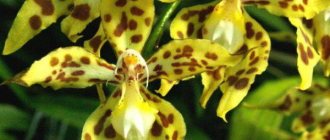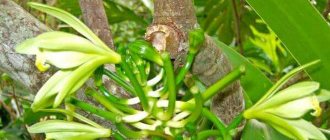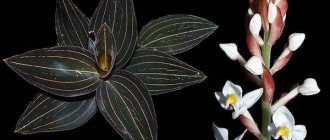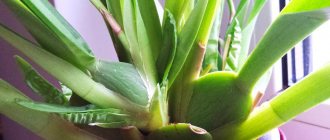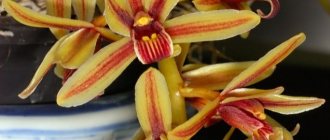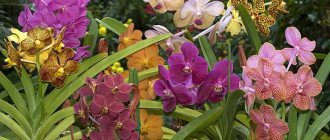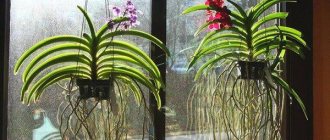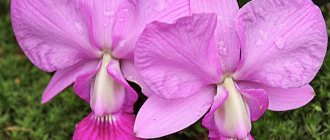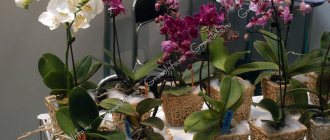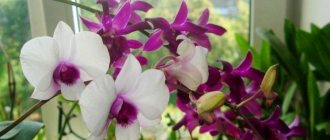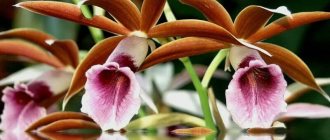Author: Elena N. https://floristics.info/ru/index.php?option=com_contact&view=contact&id=19 Category: Houseplants Published: January 04, 2019Last edits: June 06, 2021
- Care during flowering
- Zygopetalum intermedium
Zygopetalum (lat. Zygopetalum) is a small genus of epiphytic, terrestrial and lithophytic plants of the Orchidaceae family, growing in tropical regions of South America, with most of the representatives of the genus coming from the rainforests of Brazil. There are only 15 species in the genus, and some of them are so popular in indoor culture that breeders had to start developing varieties and hybrids of zygopetalum. The name of the genus is derived from the Greek words, which are translated as “gather in pairs” and “sepal” (“petal”), and characterizes the structure of the zygopetalum flower.
Description and distinctive features
Let's take a closer look and find out what the Zygopetalum orchid looks like: description and care at home:
- In the genus Zygopetalum only 15 types. The translation doesn't explain much. They are like “connecting sepals.” These are not like butterflies;
The Zygopetalum orchid is a very beautiful and rare flower. - Even experts consider this species to be rare ;
- If you like detective stories. Nero Wolf mentions this plant in his works. Here she is “Miss Tropics”. Flexible and curved;
- Experts are more inclined to believe that this type of orchid is rather capricious . And they add. As in the whole family, there are no simple ones.
Consider the plant itself:
- It is formed in the form of a ladder escape. And in the pot there seems to be a nest of several pseudobulbs. New ones appear a little above and to the side of the old ones. What is a pseudobulb : Orchid stems thickened at the bottom;
- Green, smooth, elliptical (oval) shaped formation;
- 6-7 cm long (height). Flattened.
Please note! Flower shops OBI and IKEA will most likely offer you interspecific hybrids - Zygonisia, Zygolum .
Description of the plant
Thanks to its ease of growing and interesting large-lipped flowers , Zygopetalum is one of the most beloved sympodial orchids. In nature, it is distributed mainly in Brazil. In culture, capricious species of plants are rare; zygopetalums are represented mainly by hybrids and varieties of spotted zygopetalum (Zygopetalum maculatum).
Zygopetalum is a sympodial, predominantly terrestrial orchid with a maximum height of up to 60 cm. Its pseudobulbs are very large, ovoid, up to 7 cm in height, and the roots are numerous and thickened. Each pseudobulb produces from 2 to 5 light, light green, folded-belt-shaped or lanceolate, pointed at the ends, glossy, straight leaves up to 40 cm long.
The flowering of this orchid in indoor format shifts and depends on the length of daylight hours, most often it occurs in spring and summer. Zygopetalums are unique orchids that bloom on young, not fully mature shoots. The inflorescence is slender, up to 60 cm high, growing from the base of the pseudobulb. A loose raceme with few flowers most often bears only a few luxurious flowers.
With an average diameter of 8 cm, zygopetalums captivate with their wavy, massive, vaguely defined three-lobed lip with expanding and raised lateral lobes, which contrasts surprisingly well in color and shape with the pointed “petals” around. The sepals are almost the same size as the petals. The style is shortened, the anther is petal-shaped. Zygopetalum flowers last on average about a month, with a maximum of up to 5 weeks.
The color palette of zygopetalums is varied, it usually includes yellow-green, blue, blue, purple and violet, brown shades. The flowers are decorated with spots and strokes, watercolor stains.
Zygopetalum is one of the fragrant orchids whose sweet scent is often reminiscent of lilac and spice. Unfortunately, fragrant flowers are not typical for all hybrid varieties; it is better to check the aroma before purchasing.
For other fragrant orchids, read the article 7 most fragrant orchids with a spicy scent.
Zygopetalum, or Zygopetalum. © whiteflowerfarm
Varieties of Zygopetalum orchid
Mackay
- The most famous . Maybe popular;
- His mistresses consider him the most beautiful ;
- Still would. White lip with purple or reddish lines and dots;
- Very often used for breeding new varieties . With her participation there are already more than 20 of them.
Zygopetalum mackaii.
Also Mackay.
Maxillare. Zygopetalum maxillare
- The violet color disperses evenly into a faint violet tint towards the edges of the lip;
- The length of the peduncle reaches 35 cm . Each has 6-8 flowers;
- The burgundy-brown color almost completely covers the green petals at the base.
Z. maxillare.
Blue Angel
Those who saw it in person remembered more than the color. And the aroma. It reminded them of ground black pepper.
Zyg. Rhein Blue Angel.
Luisendorf. Zygopetalum Louisendorf
Very sweet aroma . They even take him out of the bedroom. Ardent lovers of these flowers.
Zig. Louisendorf.
Homeland and territory of distribution in nature
The nature of South America has gifted everyone with an amazing plant from the orchid family. The whole genus Zygopetalym (zygupetalum). The tropical rainforests of Brazil, Venezuela and Colombia have the most of them. But they grow:
- In Peru;
- Bolivia;
- Paraguay;
- And Mexico.
For us they are a curiosity. Feels great :
- On the trees;
- Stones;
- Earth.
And it is not a parasite in relation to other plants. In nature, these are epiphytic and lithophytic plants :
These extraordinary orchids grow on trees, rocks and the ground.
- Epiphytes (Greek: “on plants”) are plants that grow or are attached to other plants (trunks or branches). And it does not receive any nutrients . They are not parasitic;
- Lithophytes (from the Greek “stone” and “plant”). Plants that have adapted to life on stones and rocks (dolomite, limestone, marble). There are more of them in the cracks .
What is the difference from other types?
The Zygopetalum orchid is distinguished by its unusual growth of stems and belongs to the sympodial type . The creeping rhizome grows in steps - each new part rises above the base of the old pseudobulb. This variety is distinguished by the unusual structure of the flower itself; pointed petals grow together at the base of the central column.
The variety, unlike other orchids, does not tolerate alternate “drying” of the substrate.
Root shoots do not have a protective layer that is capable of retaining moisture in the substrate.
Reviews
Natalia. “My story as a florist is similar to many. There were several pots of violets on the windowsill. Even ordinary watering was not part of my duties. I was not puzzled. But she didn’t show any initiative. Growing up, my attitude towards flowers changed. These flowers brought comfort and beauty. And now the collection includes flowers whose names many cannot pronounce correctly. Things don't always work out. There are also miscalculations. Some of them couldn't even be saved.
But there is already solid experience. Including the maintenance and care of orchids. Many friends ask for advice. I'll be happy to explain. After my stories, some people got their own orchids. Fears about complex care are already a thing of the past. More than a dozen phalaenopsis.
And now Zygopetalums have already appeared. They are even easier to care for. What can you grow without desire? And it doesn’t matter that some don’t have names. They are just white, pink, yellow. Such beauty is worth the effort, effort, and money.
So I advise many to put aside doubts about orchids. In reality, everything is much simpler. It is imperative to create the necessary conditions for these beauties. To admire beautiful flowers. It's within your power.
I do not recommend using clay pots. Roots can grow into them. And get damaged during transplants.
I don’t recommend buying and transporting orchids in the cold winter.”
Alexander. “I already have good experience in growing orchids. Almost ten years. There are now much more opportunities to acquire them. Take the Internet, for example. Varieties. Care. Everything for growing them (pots, soil, fertilizers). Detailed care tips. I will note on my own behalf. There are enough contradictory ones. For some they are suitable. I want to share my observations. I water the flowers without immersing the pots in water. I spill it around the edges of the container. Until water flows out of the pot.
I pay special attention to high-quality lighting. There are many flowers. Lights for each shelf. After the store I will definitely replant it. I select convenient containers. I completely replace the soil. I carefully examine the roots. I definitely remove dried and damaged ones.
Now they like to add coconut shavings to the soil. I'm deleting it. And I advise you. The soil must contain fine coniferous bark, peat, perlite and charcoal. Keep in mind. The roots are fragile and break easily. I definitely feed it with humus fertilizers (Gumate-7). 2 times a month. Without this you cannot see flowers.
And remember. The soil should not be allowed to dry completely. They are from the humid tropics."
Marina. “My orchid lovers and I came to the same conclusion. Don't be afraid to buy them. Although not exactly cheap. Our conditions allow us to provide them with conditions for flowering. Of course, we need to take care of this. Reading reviews also helps a lot. There are a lot of people there: “Oh, I bought this beauty. What is this? And what to do next?
But there are a lot of useful tips. Some of my friends place this orchid on loggias in the summer. Even in gazebos. And they bloom! I want to try it myself.
High humidity (about 60%) needs to be constant. And I water it often. Moderately. That's why I ventilate the rooms often. It is necessary to carefully monitor the condition of the soil.
Every month I feed it with humus. Be careful with nitrogen fertilizers. They can burn the roots. How can you determine the condition of the soil. And the need for watering. Root color (grayish). The moisture is gone - the weight is lighter.
About lighting and backlighting. Excessively bright lighting promotes rapid growth of flower stalks. But the pseudobulbs lag behind and do not have time to ripen. This negatively affects the ability to bloom in the future. Low light does not allow them to bloom. We need a golden mean.”
External characteristics
Florist specialists classify it as a group of horizontally growing plants.
They are called sympodial (from the Greek “together” or “many”):
- This orchid has several growing points. Shoots grow from them and transform into pseudobulbs;
- So they disperse across the width of the pot. Towards its edges, in the photo you can see this;
- United by one rhizome (rhizome);
- From these growths, as it were, 2-4 leaves grow. And a peduncle.
This orchid has several growing points, from which several shoots are formed.
On a note! Pseudobulba lives 2-3 years. Having formed a peduncle and given it the opportunity to bloom, it itself no longer grows. A new shoot usually appears at the base.
The difference between monopodial orchids (phalaenopsis) is that the leaves grow one above the other . And the peduncle grows from the axils of the leaves.
Mature plant height
It must be specified. So that they do not mistakenly think that the orchid is creeping. And choose the appropriate place . And the grown leaves and flower stalks necessarily bend.
Number of leaves
Quite a lot of leaves are formed . Few people count them. But to control the condition of the plant, you need to know. Each pseudobulb produces 2-4 leaves. And the bush looks solid.
Maximum peduncle length
And they grow up to 50 cm with proper care and conditions . There can be up to 8 pieces on perennial plants. And each has 6-10 flowers.
Can you imagine such a bouquet? You will see and believe.
Diameter, flower shape
7-8 cm will be exactly. On the line. If you measure it. The way it is. There is more on the Internet. Especially in the price lists of selling companies and entrepreneurs .
But it's not the size that surprises. And its shape. Five elongated petals of course. But most of all the lip. He even calls it spade-shaped . I prefer the comparison with a fan.
Main features of flowering
Nature is difficult to understand. When does it start to bloom? How long does it bloom? Are there these periods of rest? What does repeated mean? There are a large number of them there. Constant climate . In the tropics, some have just bloomed, while others have already faded. But it blooms on not yet fully formed pseudobulbs.
Period
In an apartment, we create the conditions ourselves . Two blooms per year. And they were accustomed to the intervals between flowerings (dormant periods). This may not be the correct wording.
Duration
You always want the flowering to last for a long time . You will definitely be able to see the flowers for 5-6 weeks. On one peduncle. And then how to grow.
Is it possible to do it again?
Amateur flower growers talk not only about repeated flowering. They call them periodic . And there. Who cared how? But two flowerings a year are considered a great success. At home.
Stimulation
How to stimulate flowering? There are most questions about this in the reviews . After all, they bought it to admire the flowers. And not by roots:
- Feeding with humus is very useful;
- Lowering the temperature to 14-18 degrees seems to push the plant towards this process;
- Reduce lighting time by 2 hours. Within 3-4 weeks.
Maintenance and care
Optimal conditions of detention
Home care is a very painstaking job for a beginner. How to keep such an orchid in your apartment. What conditions? Remember. Where did it come from? What are the conditions there? And your hybrids are even more stable. I would like to draw your attention to two concepts :
- Useful and recommended terms . When the plants bloom and smell;
- Portable conditions . This is when they can withstand unexpected peaks and surges without any serious consequences: For zygopetalums, there is no need to be too clever. A damp and cool environment is quite suitable : 15-25 degrees during the day are more beneficial. And at night it’s about 15 degrees;
- And the rest period during the day is 16-18. And at night 13-16 degrees.
- Pallets with wet expanded clay;
- Neither south nor north. So pick up the southeast. Or just east;
Replanting after shopping in a store
Needs to be replanted. Although these orchids do not respond very well to transplantation. And what prompts this. You don't know the condition of your plant :
- What roots? Refresh and disinfect;
- And in most cases the soil is temporary. And abundantly watered by sellers. So as not to dry out;
- And it's better to change it. Prepare yours. Home.
Watering and fertilizing
Two irrigation options are used . After the procedure, you are given the opportunity to dry. When the roots are covered with velamen. The second option does not involve drying.
Take filtered water . Better rain and settled. Use a cocktail of distilled and settled water. Fifty fifty. The salts in the water only harm the leaves. And the roots.
Attention! A coating (white or yellowish) may appear on the leaves. Can be removed with milk. And a solution of citric acid will help.
When flowering, water more :
- Usually - once a week. Spring and autumn;
- 1 time every 3 days in summer;
- Once every 12-15 days – in winter.
Orchidists (or orchomaniacs) advise. almost daily in the summer . A little. Or moderately. It is easier to keep the soil moist.
Watering methods:
- Immerse the pot in water for 15-20 minutes. Leave to drain;
- And all in the morning. Every day is very good. Little by little.
Advice! Do not let the soil dry out completely. Let it be a little damp. Like in the tropics. The plant compensates for the lack of moisture from leaves and pseudobulbs. This dehydrates them and prevents them from flowering.
What needs to be fed is Zygopetalum:
- And not just anything. And more specifically. Humus. Without it, don’t even dream of flowering;
- Diagram of specialists. Before flowers appear - phosphorus and potassium. After flowering - nitrogen;
- Read the ingredients of the fertilizers you buy! At your discretion and decision - once every 2-3 weeks.
Stimulating flowering
A drop in temperature is not dangerous. And even useful. If it's not important. It can just contribute to the emergence of new flower stalks .
After flowering, what to do with the arrow?
There are no more flowers. They have bloomed. Assess the condition of the peduncle . It starts to dry out. And pseudobulb. But she should have young shoots. Future pseudobulbs and peduncles. Remove them after drying.
Watering should be reduced. Can also be placed in cooler places. To activate the formation of flower stalks .
Prevention of diseases and pests
Think about proper care. And provide the necessary conditions :
- Temperature;
- Illumination;
- Humidity;
- Containers for plants;
- Suitable soil;
- Timely watering, fertilizing and replanting.
Then you will deal less with diseases and pests. But you need to know them. To promptly identify and take action :
- Diseases (more about them below);
- Pests. Just like regular flowers. Spider mite. A warm shower will help get rid of it. If necessary, repeat it.
Home care instructions
Selecting a location
The zygopetalum orchid grows well only in partial shade. It is better to place the pots on the western or eastern windowsill. South windows require shading with a light curtain, especially at lunchtime. The northern location requires additional lighting with special lamps for 4 hours a day.
Soil preparation
The substrate for this variety is loose, moist, and drained.
The drainage composition must include pieces of bark and expanded clay, and foam crumbs. Perlite is added to the soil to retain moisture. Vermiculite is added to maintain the looseness of the substrate.
Soil composition:
- Moss – sphagnum – 1 tsp.
- Turf soil – 1 hour.
- Peat – 1 hour.
- Dry leaves – 1 tsp.
- Drainage.
Pots
For novice gardeners, it is better to use transparent plastic pots to observe the condition of the roots and the integrity of the soil.
For good breathability, it is recommended to make drainage holes not only at the bottom of the pot, but also along the entire side surface of the container. Wooden boxes and slatted baskets are also used.
Temperature
The temperature regime for the zygopetalum orchid is moderate. Summer air temperature is 24 – 25°C during the day and up to 18 – 19°C at night. In the autumn-winter period, you need to reduce the temperature to 18 - 21 °C during the day, and at night to 16 °C.
For normal development, a daily temperature difference of 3–4 degrees should be observed.
When spring warmth sets in, the pots can be taken out into the fresh air - onto open verandas and loggias. The mid-latitude climate allows the plant to experience a natural temperature difference between night and day.
Humidity
Required air humidity is up to 70 – 90%.
Acceptable limits for zygopetalum are 60%. In hot weather, you should spray the flower and wipe the leaves with a damp cloth. Also, open containers with water are placed next to the pots. You can place the pots on a damp layer of expanded clay. In greenhouse conditions, special steam generators are used to increase humidity, artificially humidifying the air.
Lighting
The zygopetalum orchid prefers bright but diffused light. Bright direct rays are contraindicated for the flower. Leaves are an indicator of the received light. If spots appear on the leaves, the windows should be shaded and the pots should be moved away from the windows. If the leaves become dark, backlighting is added.
Watering
This variety loves moisture. In summer, watering is abundant and regular. Be sure to spray in the morning. It is recommended to give the flowers a warm shower twice a month.
When watering, water should not fall on the inflorescences themselves. Flowers lose their attractiveness. In winter, watering is reduced. The substrate should not dry out, but the substrate should not be allowed to become damp.
After showering the leaf axils, the rosette must be wiped with a cotton swab.
Water for irrigation should only be used that has been settled and purified. Rainwater can be used. It is recommended to use submersion irrigation. The pot is placed in a large container of water for 15 - 20 minutes. After the procedure, the water must drain completely; it is drained from the pan.
Top dressing
The species requires frequent but dosed feeding.
Potassium and phosphorus fertilizers are usually used. You can use liquid fertilizers specifically for orchids. To ensure uniform distribution of mineral fertilizers, fertilizing is combined with watering. During the period of active growth, nitrogen fertilizers are used to increase green mass.
In summer, flowers are fertilized 2 rubles. in Week. In winter, it is enough to fertilize the substrate once a month.
Transfer
The plant should be replanted every 2-3 years, when the roots have grown too much and the pot has become small. A transplant is also necessary when the substrate decomposes or becomes infected with pathogenic infections. The procedure is carried out in the spring, before the buds form.
Transplantation scheme:
- The soil in the pot is well moistened.
- The flower is carefully removed.
- The root is cleared of old soil.
- Old, dry, damaged root shoots are trimmed.
- Dried stems are also removed.
- The cut areas are treated with disinfectants and charcoal.
Green young pseudobulbs should be preserved; they contain a supply of essential nutrients.
We invite you to watch a video about how to transplant a Zygopetalum orchid:
Landing
Priming
You already know. The roots of the plant are almost completely in the soil (almost 80-85%). They are covered with numerous root hairs . This provides moisture to the entire plant. And determines the soil requirements. Constantly wet and loose.
Optimal soil composition:
- Finely chopped tree bark;
- Charcoal;
- Perlite;
- Expanded clay;
- Sphagnum moss;
- Peat;
- The soil should not dry out.
They can also be grown on blocks. In the greenhouses. Coconut fibers and a thin layer of moss are just right there .
Optimal capacity
Plastic or clay pots. fit freely in them .
Provide good drainage :
- Expanded clay. Vermiculite;
- And there is one at hand. Fine and washed crushed stone. Small sea pebbles. And walnut skins.
Technology and timing
Repot your orchid only when necessary . For them, this is the period after flowering. Young roots grow more actively. These orchids do not like changing pots.
The technology is known and is not difficult :
- Prepare the container and soil;
- Carefully remove the plant from the old pot. As if shaking out;
- Remove old soil;
- Cut off damaged and dried roots and bulbs;
- Treat the cut areas with charcoal. And let them dry a little;
- Place drainage in a pot (expanded clay, perlite);
- Set the plant;
- Cover with soil.
Be careful! Pseudobulbs should be on the surface of the soil. Don't fill them up. Once every 3-4 years. Water every other day or two. Not earlier.
Transfer
This orchid does not need regular replanting; moving to a new pot will be required when a creeping shoot with pseudobulbs begins to hang over the edge of the container or the roots crawl out into all the drainage holes and onto the surface of the substrate. In this case, the shrunken or damaged parts are cut off, and the cut areas are sprinkled with powdered fungicidal preparations or charcoal.
Replanting when the peduncle is forming is unacceptable, as stress can cause the plant to shed its buds.
Substrate
Regular soil is not suitable for zygopetalum. It is necessary to purchase a substrate that meets the following requirements:
- permeable and friable;
- with the addition of perlite for better air exchange;
- with vermiculite to prevent caking.
It is best to purchase a high-quality ready-made substrate for orchids, consisting of coniferous bark, sphagnum and charcoal.
Pot
The main requirement is transparency. This is necessary because the roots develop bacteria necessary for normal growth, which live only in the presence of light. It is undesirable to use glass containers, as they can lead to overheating of the root system, but plastic ones will be just right. There must be large drainage holes at the bottom.
Landing technique
A drainage layer at least 5 cm thick must be placed at the bottom of the pot, after which the roots of the zygopetalum are placed in it and soil is carefully poured into the remaining voids.
The main nuance is that the root collar and pseudobulbs are not immersed in the substrate, as this can lead to rotting during cultivation.
After transplantation, the orchid is watered by immersion in warm water. The first month after this, no feeding is carried out.
Diseases and their treatment
Yellowing and lethargy of leaves
This could be a request to improve the lighting. Options for you to consider. Based on your conditions and capabilities :
- Backlight;
- Placement on the brighter sides.
Black spots on leaves and bulbs
for you to help :
- Is this not the characteristic coloring of the leaves?
- Maybe the plants are in the sun? Then sunburn is possible.
Fungal diseases
The fungal disease gray rot is very dangerous for orchids . The leaves become covered with dirty spots.
The roots have rotted. How to save?
In order to save an orchid, you must follow the rules:
- Prepare scissors and pruning shears. Process them ;
- Trim off any damaged parts;
- Treat (lubricate) with activated carbon . Let them dry for 2-3 days. Make sure there is no rot;
- You can equip a mini-greenhouse. Or keep it in a pot;
- Treat possible root growth points with a succinic acid solution;
- You can also use vitamins B1, B6, B12. It will take a lot of time. About six months. And patience.
Reproduction
Division is the most acceptable way to propagate the Zygopetalum orchid . Each separated part should have 2 - 3 healthy pseudobulbs.
Diagram of rhizome division:
- The roots are cleaned of the old substrate, rotten and dry roots are cut off.
- The flower is divided into several parts.
- The separated parts are sprinkled with crushed coal and dried in the open air.
- Seedlings are immersed in moss - sphagnum in special containers for ripening.
- Water regularly until rooting.
